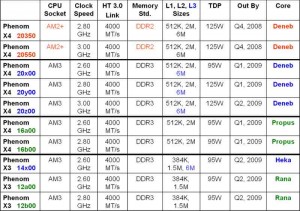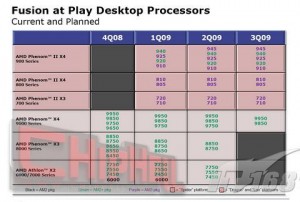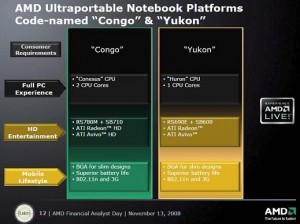AMD would be releasing its 45nm silicon-based desktop CPUs, built on the Deneb, Propus, Heka, Rana and Regor cores, to bring out quad-core, triple-core and eventually dual-core processors. AMD has discarded the 5-digit number scheme that was earlier reported, and in its place, adopted a three-digit scheme. The quad-core Deneb chips get a 9xx model number and 8xx number depending on the clock-speeds and cache size, Propus-based chips get the Athlon X4 branding.
Heka-based chips get Phenom II X3 7xx branding, with Rana getting Athlon X3 4xx. Regor dual-core trails with Athlon X2 2xx. It is important to note that AMD seems to have made a critical change to the Deneb core, releasing 2 models based on cache-arrangements. The first kind features a total of 8 MB cache (4x 512K L2 + 6M L3) and one with 6 MB total cache.
There’s a bit about the processors’ launch schedule given as well, all the purple marked numbers are AM3 package based, while green ones are AM2+. Another slide reveals that AMD will come up with a multiplier-unlocked Phenom II X4 940 Black Edition (AM2+) in Q1, 2009. AMD itself projects this chip to have overclocking potential far beyond 4.00 GHz on liquid-cooling, which it describes as “Massive Headroom”. We’re trying to source larger images at the moment.
AMD would be releasing its first desktop processors based on the 45nm silicon fabrication process, based on the newer Deneb core. The company is said to have made several tweaks to the original K10 design and equipped the core with 300% the amount of L3 cache as its 65nm Agena parts. The only thing got us wondering was what would be its nomenclature like? Well, be surprised to know that after Phenom X4 9000 series, the company plans to continue the numbering with a 5-digit model number scheme with x1000 unit deviations between models. A rather confusing naming scheme, as suggested by the chart provided, seems to have been adopted.
It is now clear, that there will be two distinct kinds of Phenom X4 45nm chips: those which continue support for DDR2 memory on the existing AM2/AM2+ sockets, and those which are exclusive to the AM3 socket and feature support for DDR3 memory, DDR3 1333MHz at that. The processors would feature dual 64-bit memory controllers, which could be ganged for a single 128-bit wide memory interface, or un-ganged to step up multi-tasking efficiency.
The first two Phenom parts out are, Phenom X4 20350, clocked at 2.80 GHz, and a higher model, Phenom X4 20550, clocked at 3.00 GHz. Both these parts are DDR2 compatible which extends the life of current AM2/AM2+ platform. Both have rated TDP of 125W. This is an improvement over the 65nm parts, which had a third of the amount of L3 cache and the 2.60 part being rated at 140W.
Next up, is a fleet of AM3 socket processors that use DDR3-1333 as the memory standard. Their nomenclature starts from the 16xxx range, extending up to 20xxx depending on the clock speed. It can be seen that the parts with a full 8 MB cache (4x 512 KB L2 + 6 MB L3) feature a 20xxx number, while those based on the Propus core which lack L3 caches, feature a total of 2 MB cache (4x 512 KB), have 16xxx series number depending on their clock speeds. Interestingly, there’s a part with 3 MB cache featured. We’re not sure how the math works out. Finally, 45nm Phenom X3 parts are listed, with their two kinds of cores depending on the presence of L3 caches. They use 14xxx for those with the L3 cache (Heka core), and 12xxx for those without them (Rana core). As you can see, the model numbers are now a complete deviation from the PRN system AMD used only an year ago with its Athlon 64 X2 chips. Also mentioned are their tentative release dates. AM2+ Deneb chips are just around the corner.
Di hari Jumat minggu lalu AMD mengatakan bahwa tahun depan mereka akan mengeluarkan berbagai produk yang ditargetkan kepada segmen ultra portable dengan platform Congo dan Yukon. Tetapi jangan salah, AMD tidak menargetkan segmen netbook dengan kedua platform ini, seperti yang dikatakan CEO Dirk Meyer bahwa AMD “akan mengacuhkan fenomena netbook” dan menargetkan segmen ultra portable berfitur lengkap yang lebih mirip seperti MacBook Air.
Hal ini juga ditegaskan kembali oleh Bahr Mahony, direktur divisi marketing notebook yang mengatakan bahwa AMD “akan menawarkan platform Congo dan Yukon sebagai alternatif (untuk prosesor dan chipset netbook). Sudah ada banyak pelanggan yang tidak puas dengan pengalaman pemakaian di platform notebook mini tersebut.” Juru bicara AMD John Taylor juga mengatakan hal yang sama bahwa AMD secara spesifik tidak menargetkan segmen netbook (notebook dengan layar berukuran 8 hingga 12 inci).
Strategi AMD tampaknya cukup baik karena mereka mengincar segmen yang lebih besar dan lebih baik daripada netbook. Kategori ultra portable (seperti MacBook Air, Envy) sudah dipenuhi berbagai produk yang baik tetapi mahal. Mengapa hingga sekarang belum ada produsen PC yang menawarkan notebook 13 inci yang ringan, berfitur lengkap tetapi berharga di bawah $1.800? Mengapa tidak membuat produk seperti itu yang seharga $600 atau $700?
Di samping keluhan utama tentang netbook (layar dan keyboard yang terlalu kecil), sudah banyak pengguna yang pada akhirnya merasa kinerja netbook kurang baik, terutama dalam hal grafis. MacBook Air adalah contoh terbaik untuk ini. Apple pada awalnya mengemas solusi integrated graphics Intel ke dalam MacBook Air, tetapi pada akhirnya beralih ke GeForce 9400M pada model terbarunya. AMD tidak akan melakukan kesalahan yang sama, Pat Moorhead mengatakan bahwa mereka akan mengemas kartu grafis RS780M ATi ke dalam Yukon dan Congo.
Baik Congo maupun Yukon akan debut di pertengahan pertama tahun depan. Baik Yukon maupun Congo adalah platform — istilah yang menggambarkan kombinasi dari berbagai komponen. Congo yang berharga lebih mahal akan menggunakan CPU Conesus AMD yang akan datang. Conesus adalah sebuah CPU dual core 65nm dengan cache 1MB yang didukung DDR2 dan kartu grafis RS780M. Sedangkan Yukon yang merupakan varian murah dari Congo akan menggunakan CPU Huron dengan kartu grafis RS690E.
Hits: 28







Leave a Reply